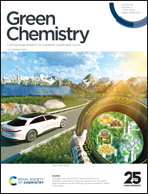Evaluation of green chemistry metrics for sustainable recycling of platinum group metals from spent automotive catalysts via bioleaching†
Abstract
This work evaluates sustainability indicators of the biorecovery of platinum group metals (PGM) from spent automotive catalysts (SAC) with due consideration of the environment and efficiency and forms the basis for the evaluation of environmental sustainability. Green chemistry metrics have been quantified for all the processes involved in the bioextraction of PGM from SAC under different experimental conditions. Three different cyanogenic (hydrogen cyanide forming-HCN) bacteria namely Pseudomonas fluorescens, Bacillus megaterium, and Chromobacterium violaceum were used in two-step bioleaching. These bacteria produce cyanide as a secondary metabolite that forms water-soluble complexes with PGM. Bioleaching experiments were performed at different pulp densities (i.e., 0.5% w/v, 1% w/v, 2% w/v, and 4% w/v) to examine their effects on PGM extraction and green metrics. For green metrics calculations, metal and cyanide limiting reactions were performed and four different boundary conditions were defined. Boundary conditions were defined based on the limiting reactants, desired metals, and chemical reactions. Furthermore, green metrics were calculated for an individual metal (i.e., platinum, palladium, or rhodium) and for the overall bioleaching process. This is the first study that reports an in-depth analysis of the environmental sustainability of the PGM biorecovery process by quantifying the green metrics under diverse experimental conditions.

- This article is part of the themed collection: Measuring Green Chemistry: Methods, Models, and Metrics


 Please wait while we load your content...
Please wait while we load your content...